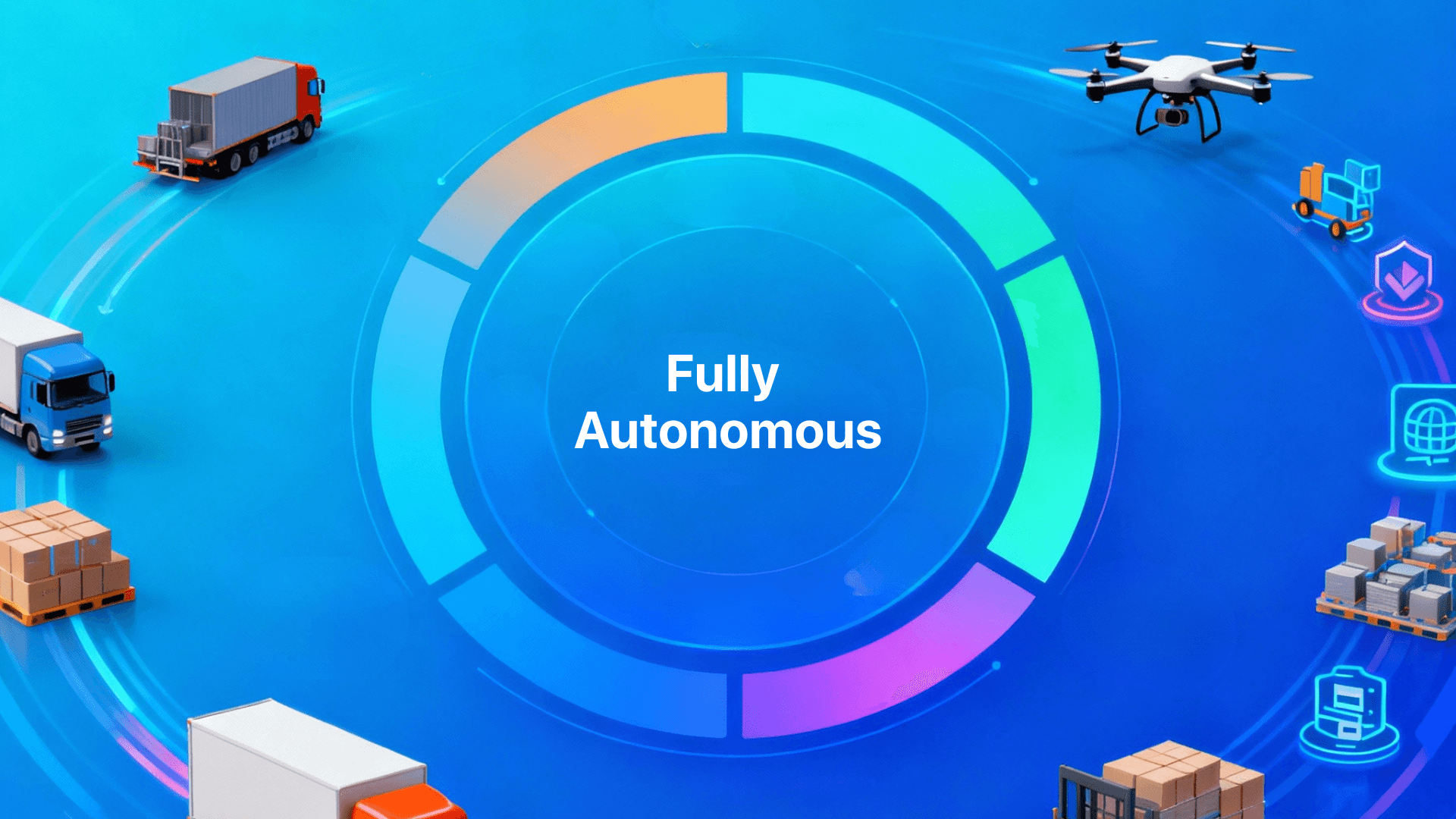AI Agent Maturity Assessment: Benchmark Logistics Against Leaders 2025
Friday, 24 Oct 2025
|
The AI Agent Maturity Assessment: Benchmarking Your Organization Against Industry Leaders
Introduction: Why Assess AI Agent Maturity Now?
AI agent maturity assessments are essential for logistics executives to benchmark against industry leaders, revealing gaps that could cost 15-20% in efficiency and revenue if unaddressed. As agentic AI transforms supply chains—enabling autonomous orchestration across forecasting, fulfillment, and risk management—organizations at lower maturity levels face a 30% higher risk of disruption impacts compared to mature peers. For CEOs, CXOs, and COOs, this evaluation framework identifies investment priorities, measures progress, and aligns with forecasts showing 50% of chains achieving autonomous execution by 2030.
This comprehensive guide provides a five-stage maturity model tailored to logistics, drawing on systematic reviews and benchmarks from IBM, McKinsey, and ABI Research. By assessing your operations against leaders like Amazon and DHL, you'll uncover actionable steps to prioritize data infrastructure, talent development, and integration, accelerating ROI from 250% for advanced adopters. In a market where AI drives 26.6% CAGR through 2029, benchmarking ensures competitive positioning amid $1.5 trillion in annual disruption costs. Executives using this framework can target 20-30% gains in resilience and customer retention, turning AI from a tactical add-on into a strategic powerhouse.
The Evolution of AI Agents in Logistics: From Tools to Autonomous Orchestrators
AI agents in logistics have evolved from basic automation to agentic systems that reason, decide, and execute multi-step processes autonomously, reducing manual interventions by 80% in mature implementations. Unlike traditional AI, these agents use large language models combined with optimization algorithms to handle complex tasks like dynamic rerouting during port strikes. Maturity assessments evaluate this progression, focusing on dimensions like data processing, decision support, and resilience, as identified in systematic literature reviews of 66 studies.
In supply chains, low-maturity firms rely on siloed tools for forecasting, leading to 25% higher stockouts, while leaders deploy multi-agent orchestration for 95% prediction accuracy. This evolution underscores the need for standardized frameworks, as 64% of leaders view AI as critical for investments but cite data fragmentation as a $600 billion barrier. By benchmarking, executives can map their journey from ad hoc pilots to optimized ecosystems, aligning with GenAI trends that supercharge automation. The result is not just efficiency—it's strategic reinvention, where agents become the core of supply chain intelligence.
Assessments reveal that 94% of firms plan AI for decision support, yet only 40% have scalable integrations, highlighting the maturity gap. For logistics, this means evaluating against real-world benchmarks: DHL's AI cuts delivery times by 25% through predictive platforms, setting the standard for maturity.
The Five-Stage AI Agent Maturity Model for Logistics
The proposed maturity model, synthesized from SCM-specific literature and industry reports, outlines five stages: Initial, Emerging, Defined, Managed, and Optimized. This framework accommodates logistics' unique demands—real-time data flows, cross-functional collaboration, and disruption resilience—providing KPIs for each stage. Leaders like Amazon operate at Stage 5, with agents orchestrating 98% on-time deliveries, while most firms lag at Stage 2-3.
Stage progression requires addressing enablers like ethical compliance and talent pathways, ensuring scalable adoption. This model empowers executives to diagnose readiness, prioritize gaps, and track against competitors, fostering 19.6% annual efficiency gains.
Stage 1: Initial/Ad Hoc—Fragmented Experiments
At the Initial stage, AI agents are deployed sporadically for isolated tasks like basic demand forecasting, with 50% of efforts failing due to poor data quality and lack of governance. Organizations here experience 15-25% suboptimal routes from manual overrides, as agents lack integration with TMS or WMS. Benchmark: Only 10% of Stage 1 firms achieve under 20% automation, contrasting with leaders' 80%.
Investment here focuses on pilots, but without strategy, ROI stalls at 50%, per McKinsey benchmarks. Executives must recognize symptoms like siloed data costing $600 billion industry-wide, signaling the need for foundational shifts. Progress markers include completing one successful pilot with 10% efficiency uplift.
Stage 2: Emerging—Building Foundations
Emerging maturity features dedicated AI teams experimenting with agents for inventory optimization, achieving 20% better forecasts but hindered by data silos. Agents here monitor streams reactively, reducing stockouts by 15%, yet scalability issues limit multi-agent use. Against leaders, Stage 2 lags: Walmart's super agents unify chains for 99.2% in-stock rates, while these firms see 30% variance.
Key challenges include talent shortages, with 79% citing skills gaps, but early integrations yield 100% ROI potential. Executives should invest in clean data pipelines, targeting 30% automation coverage. Benchmarks show progression via 40% reduction in manual queries.
Stage 3: Defined—Structured Integration
Defined-stage firms standardize agent deployments across functions, with APIs linking ERP and IoT for proactive decisions like auto-rerouting. Agents achieve 50% autonomy in logistics, cutting costs by 20% through predictive maintenance. Benchmarking reveals a 25% gap to leaders: UPS's ORION saves 38 million liters of fuel via AI routes.
Governance emerges here, with ethical frameworks reducing bias risks by 40%, enabling cross-functional orchestration. Progress is measured by 60% decision support from agents, prioritizing integrations for 150% ROI. This stage positions firms for resilience, as 76% adopt agents for supplier management.
Stage 4: Managed—Optimized Execution
Managed maturity involves agents handling 70-80% of exceptions autonomously, using ML for 95% anomaly detection in warehouses. Firms here see 30% throughput boosts via robotic coordination, benchmarking closely to DHL's 25% time reductions. Challenges like latency are mitigated with real-time NLP for supplier comms.
Investment shifts to performance metrics, achieving 200% ROI through scalability. Executives benchmark via KPIs like 90% uptime, advancing to multi-agent ecosystems. This stage fosters innovation, with 90% using AI for customer support.
Stage 5: Optimized—Autonomous Dominance
Optimized firms deploy fully agentic chains, with multi-agents executing end-to-end like Amazon's robotics for 99.8% picking accuracy. Resilience hits 95%, with agents simulating disruptions for zero-impact mitigations. Leaders here monetize AI externally, adding 10-15% revenue.
Ethical AI and continuous learning drive 250% ROI, per benchmarks. Progression requires 100% orchestration coverage, positioning for 67% autonomous dominance by 2028. This pinnacle ensures unassailable advantages.
Benchmarking Against Industry Leaders: Real-World Gaps and Opportunities
Benchmarking reveals stark contrasts: Amazon's Stage 5 agents process 40% more orders hourly, while average firms at Stage 2-3 face 20% higher costs. Walmart's AI unifies 4,700 stores for $1.5 billion savings, highlighting data maturity gaps in 47% of peers. DHL's platforms predict with 95% accuracy, outpacing Stage 3 firms' 70%.
Opportunities lie in closing these via targeted assessments: 64% prioritize AI for decisions, but only 50% invest in MV for warehouses. Leaders like Maersk save $300 million via predictive maintenance, a 30% edge over laggards. Executives can use this to identify 27.6% working capital optimizations as top priorities.
Gaps in agentic adoption—76% for suppliers—offer quick wins for mid-maturity firms. By emulating leaders, achieve 35% resilience boosts.
The Assessment Framework: Step-by-Step Self-Evaluation
This framework, aligned with ISO standards and SCM literature, involves four steps to evaluate maturity. Step 1: Inventory current capabilities across 12 enablers—data, analytics, automation, integration, innovation, resilience, strategy, ethics, infrastructure, talent, governance, and measurement. Score each on a 1-5 scale, using surveys of 490 professionals for validation.
Step 2: Map scores to the five stages, identifying gaps like 50% data silos in Stage 1-2. Benchmark against leaders: If below 3.5 average, prioritize foundations. Step 3: Analyze via KPIs—automation rate, forecast accuracy, ROI—revealing 94% decision support potential.
Step 4: Generate reports with gap analysis, recommending pilots for 20% quick wins. This process, repeatable quarterly, ensures alignment with 19.6% CAGR trends.
Identifying Investment Priorities: Targeted Allocations for Acceleration
Data and Infrastructure Investments
Prioritize data maturity, as fragmented sources hinder 50% of agents; invest 20-30% of budgets in unified platforms for 95% real-time access. Leaders allocate for IoT integrations, yielding 25% visibility gains. For Stage 2-3, focus on cloud ML for $100K+ MV systems.
Talent and Governance Priorities
Upskill 60% of teams in agentic AI, addressing 79% gaps with pathways for 40% productivity. Ethical governance—audit trails, bias checks—prevents 4% revenue fines, per ISO. Benchmark: Mature firms have 100% compliance.
Integration and Scalability Focus
Allocate 15-20% to APIs for multi-agent orchestration, enabling 3x scale without costs. Priorities include RPA for workflows, cutting manual effort by 80%. Against Amazon, this closes 30% throughput gaps.
These priorities, informed by 27.6% working capital focus, drive 250% ROI.
Measuring Progress: KPIs and Ongoing Monitoring
Track progress with KPIs: automation coverage (target 80%), accuracy (95%), resilience uptime (95%), and ROI (200%+). Use dashboards for quarterly reviews, benchmarking against 90% customer support adoption. Leaders monitor via agent performance, achieving 30% cost reductions.
Incorporate feedback loops for evolution, ensuring 50% autonomous execution by 2030. This measurement sustains 26.6% growth.
90-Day Action Plan: From Assessment to Implementation
Day 1-30: Conduct full assessment, scoring enablers and identifying top gaps. Day 31-60: Pilot one priority—like data unification—for 15% gains. Day 61-90: Integrate learnings, upskill teams, and re-benchmark for Stage progression. Allocate 15% IT budgets, targeting 100% ROI. This plan mirrors leaders' pilots, accelerating maturity.
Internal Linking: Explore More on Debales.ai
- 90-Day AI Agent Roadmap: Fast Track Supply Chain Value
- AI Agent Economics: Real Cost Savings Beyond Automation in Logistics
- 3PLs Investing 15-20% IT Budgets in AI Agents in 2025
- Multi-Agent Orchestration: Autonomous Collaboration in Supply Chains
- Agentic AI: Self-Directing Intelligence Beyond Automation in Supply Chain
Call to Action: Benchmark Your AI Maturity with Debales.ai
Elevate your supply chain: Schedule a free AI agent maturity assessment with debales.ai experts to uncover gaps and prioritize investments for 20-30% gains.
Conclusion: Advance to AI Leadership Through Rigorous Assessment
The AI agent maturity assessment framework equips logistics executives to benchmark against leaders, identifying priorities that drive 250% ROI and 50% autonomy by 2030. By progressing through stages and measuring KPIs, firms close gaps, enhancing resilience and retention amid 26.6% market growth. In 2025's agentic era, assessment isn't evaluative—it's transformative for enduring dominance.


